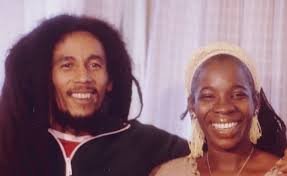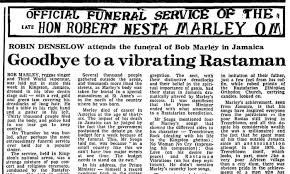Remembering Robert Nesta Marley (Feb 6, 1945 - May 11,1981)
When his music hits your eardrums, you feel no pain but a melange of emotions - joy, pleasure, melancholy, sadness, exhilaration and great delight. This has been my experience. Bob Marley’s songs have inspired, awakened, conscientized and encouraged me over the years. In the previous post, I alluded to being a die-hard R&B aficionado, but the reggae music according to Marley has a very special place in my heart.
I felt a deep connection to Bob Marley which was incomprehensible till I reached adulthood and only astrology afforded me that understanding. It was the oppositional/compatibility link between Leo and Aquarius on the astrology chart. This link connected and made inseparable Whitney Houston, a Leo and Bobby Brown, an Aquarius. It also explained the intense chemistry between Alfarita Constantia “Rita” Marley, another Leo woman and Robert Nesta Marley. As a Leo woman myself, who has an Aquarian child, you can’t make this shit up (pardon my French!). Both signs are a match made in heaven. When the intellectual, humanitarian and revolutionary Aquarius encounters the sunny, warm-hearted, generous and courageous Leo, dreams come true, particularly when both are self- aware and accountable.
Rita and Bob shared several commonalities: both were inhabitants of Trenchtown, Kingston, Jamaica; both were abandoned by their Parents and both were musically gifted. Despite the odds against them, both persevered in a union initially marked by stark impoverishment and dependency on external agents.
Rita reveals a glimpse of the man Bob Marley in her memoir, My Life with Bob Marley (2004). He was a kind-hearted and generous husband, a dedicated father, a philosophical musician, a humane employer, a thinker, an altruist, and a chronic philanderer.
His music adventure began with Bunny Wailer and Peter Tosh under the aegis of The Wailers. Bunny’s father had had a relationship with Bob’s mother which produced a child. Their struggling career eventually gained a measure of stability under the guidance of Chris Blackwell, the founder of Island Records, who unfortunately, placed Marley as the headliner of the group. The move naturally fostered internal tension and conflicts. Following the culmination of their three album deal with Blackwell, Wailer and Tosh departed the group, while Marley renewed the contract as Bob Marley and the Wailers.
The feeling of abandonment became a recurring decimal in Marley’s life as he is said to have felt abandoned by his friends. According to Ms. Rita, “They’d been so young when they got together….. and it was like being deserted by your brothers, especially in Bunny’s case, since they were related through their sister Pearl. A lot of people still don’t understand that this was such a hurt in Bob’s life, that he took it with him. Because even when he was sick and losing gravity with life, he was saying they couldn’t even call him”. (122)
What followed was the recruitment of a new singing group to provide background support and the group would comprise of established female reggae vocalists like Marcia Griffiths (of “Electric Boogie” fame), Judy Mowatt and Marley’s wife, Rita. The three friends became the I -Three and the icing on Marley’s music cake. Despite their presence, the group never became Bob Marley and the I- Three. Nonetheless, they remained a permanent fixture till Marley’s demise.
Interestingly, Marley is portrayed as a man who had the utmost love, respect for women and always recognised, acknowledged and articulated their inherent potential. His religious love was proven through the siring of multiple children from multiple women. Surely, he could have considered according the three women their due recognition in the group by the absorption of their group name. However, it appears that elements of patriarchy may have hindered such development in view of the diminishment and erasure of Rita’s status as Marley’s wife. She notes that Marley had been advised to publicly deny his marital status as it could militate against his career progression.
In any case, Marley would gain International recognition after Eric Clapton covered the song “I shot the Sheriff”. The purity, simplicity and relatability of his lyrics engendered immense traction and transnational appeal. He was admired by many American artists like Stevie Wonder, Roberta Flack, Barbra Streisand, etc. Flack visited Jamaica to have an audience with him. Wonder’s “Master Blaster” was inspired by Marley. Before Whitney Houston ever conceived a flamboyantly cinematic reinvention of Dolly Parton’s “I will always love you”, there was Stevie Wonder, who had transposed Marley’s “Redemption Song” (https://www.youtube.com/watch?v=2ZKjdTU_-Rk) to a highly sophisticated composition from its originally simple state. Both men performed together at a concert in Jamaica and a collaborative tour was planned before Marley became sick.
Marley’s musical warfare placed him under surveillance by US Intelligence Agencies. This was at a time when the embers of the counter-cultural movements were nearing crescendo. His music sparked the flames of politicial consciousness that the then status quo wished to have extinguished. Back home, he had escaped an assassination attempt. Unwittingly, he would become an International symbol of political revolution, liberation and hope. The song “One Love” and album Exodus were awarded “Song of the Century” and “Album of the Century”, respectively by Time magazine in the year 2000.
Marley incurred an injury on the big toe of his right foot while playing football in September 1975. As a true Aquarian, a severe injury was trivialized and denied the urgent attention it required. The toe would be reinjured in 1977 leading to a fall out of the nail and the development of melanoma. An amputation of the toe was the prescribed solution for the ailment. The superstar refused consent to a procedure that could turn him into a handicap. His stance was further solidified by the music machine which beholds musician as slaves to be exploited and overlooks their humanity. There was money to be made and surely no “crappy” health break or self preservation was appreciated. Public allegiances had overtaken personal commitments.
He was placed on a hectic schedule with interviews, phone calls, appearances, performances, parties, women, etc. As Rita Marley notes: “Then I realized…this is what happens when you finally lose control….as I’d been warned early on, it came with success, with stardom…Though I knew Bob was on a mission, he had gotten sidetracked in so many different ways by all the “yes” people….Still I said, “We’re losing the spiritual aspect of our dreams”. (162)
The toe worsened, while the journey through stardom and the facilitators of that journey denied Rita Marley the power to make concrete decisions concerning her husband’s health. From the onset of Marley’s relationship with Blackwell, Rita was strategically sidelined. Despite working as his background vocalist, vital information on his health were kept shrouded from her. From his collapse while jogging at the Central Park in New York in September 1980 to the Cancer diagnosis, as “the malignancy in Bob’s toe had spread to his brain” (165). The music machine knew that his death was inevitable and “they might as well continue the tour till he dies” (165). It took Rita’s intervention to bring the diabolical show to a halt.
To Marley, Rita was his protector and in her absence, “he felt as if people could do anything they wanted with him, but if Rita was there, she wouldn’t allow certain things” (167). Even though he knew this fact, he allowed his whole life to be severely hijacked and redirected by outsiders, who controlled his earnings and food.
Robert Marley was checked into Memorial Sloan - Kettering Cancer Center in New York. Further advanced treatments required a transfer to Germany where he underwent a tonsillectomy, to keep inflamed tonsils disruption of the immune system. His life was sustained beyond the time frame earlier prognosed. However in the spring of 1981, the treatment reached a dead end and he would return to a hospital in Miami where he passed on May 11th, 1981. His last words to his sons Stevie and Ziggy, respectively were “Money can’t buy life” and “On your way up, please take me up; and on your way down, don’t let me down”(168).
Marley’s legacy has enjoyed a tremendous longevity which can be credited to the unceasing dedication of his wife, Rita. Many posthumous honours have been at the instigation of the fans who saw him while alive and those born after his transition. Every February 6, a birthday concert is organised at the Universal Studios in Orlando, Florida to honour his memory. Although, many have sought to tarnish his name through the claim that Ms Rita had a revenge affair with a Jamaican footballer which produced a child while Marley was alive, it is best to hear from the horse’s mouth.
In her words, “ Though the children and I were able to manage without a father at home, there were times when we did need a man to be there, just to take up some of the responsibility that it takes to make a family. Or just to help me - because there were times when I thought nobody was thinking about me - it was still all about Bob”. (188) And to the rescue came her old friend, Owen Stewart. Their relationship had begun at the point in Bob’s career when he was completely distant from the family and basking in the arms of multiple women, at the detriment of his wife. It was Stewart who often confronted Marley about his infidelity when the latter tried to play smart through an attempt to guard his wife from male attention.
Rita’s last child Serita was sired by Owen Stewart in 1986. A word, they say, is enough for the wise.



